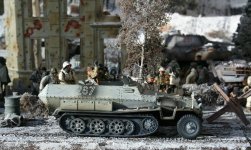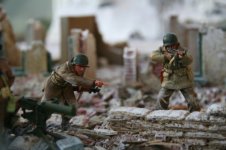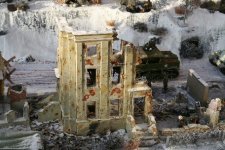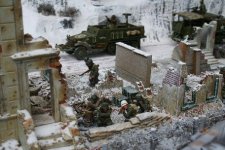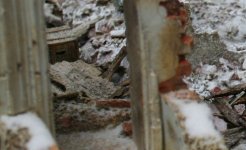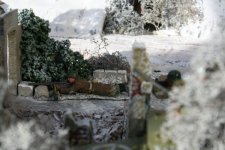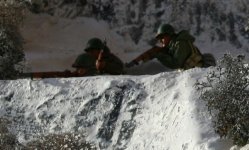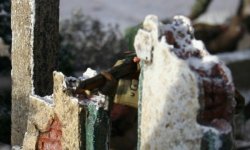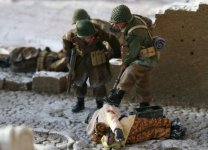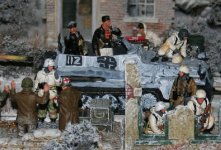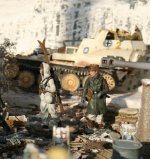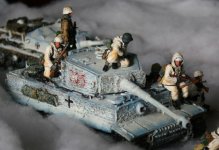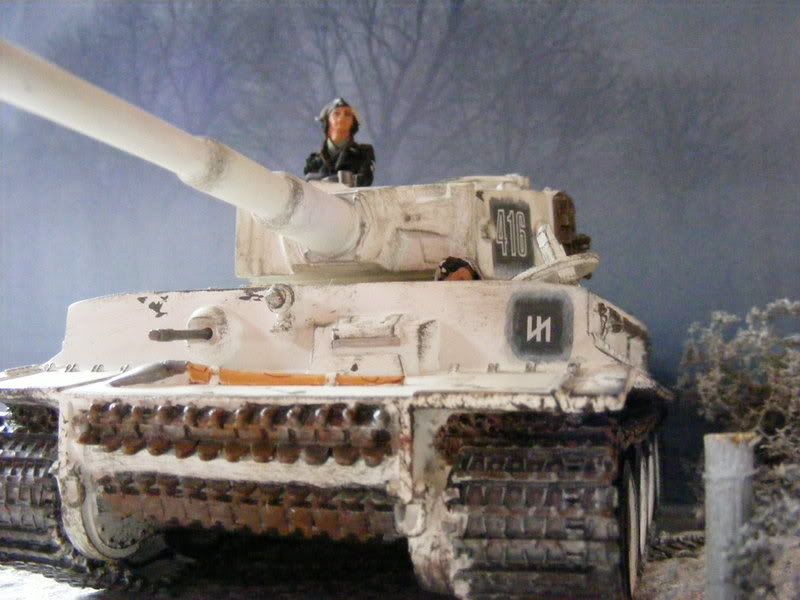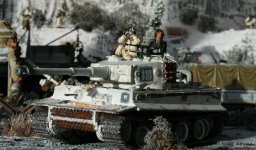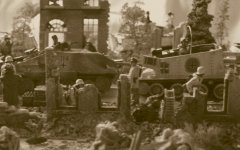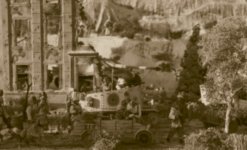http://ice.mm.com/user/jpk/106th_Recon.htm
106th Cavalry Reconnaissance Troop
in The Battle of the Bulge
by Joseph C. Haines, Lt. Col. AUS (Ret)
106th Recon Platoon Leader, World War II
What Really Happened at Grosslangenfeld, Germany
December 16-18, 1944
Lt Col Joseph C. Haines
Ltc Joseph C. Haines as a Reserve Officer November 1959
Part of the 2nd Platoon, 106th Recon Troop during Basic Training, Fort Jackson, SC 1943-44
Since World War II, I have read numerous accounts about the Battle of the Bulge detailing what happened to the various units positioned along the Siegfried Line between Belgium and Germany. None of these accounts that mention our 106th Recon Troop relate the truth about what really happened at Grosslangenfeld from dawn on December 16th until we pulled out the afternoon of December 17th.
Some of the ‘reports’ I've read are – Col. R. Ernest Dupuy’s book, St. Vith: Lion In The Way (reprint 1986, pp 50) states; "As the morning waxed, and the 423rd reports 16 December as “clear and cold,” it was evident that the enemy had taken Grosslangenfeld in the 424th Infantry sector.... As a matter of fact, we were still fighting in Grosslangenfeld until early afternoon on the 17th!! Then, on pp 55, Col. Dupuy states; The 106th Reconnaissance Troop at Grosslangenfeld disintegrated, opening Cannon Company’s left flank.... The Germans actually advanced between the Cannon Company of the 424th Infantry and the 106th Recon Troop.
WE DID NOT DISINTEGRATE!!!
And, on pp 57; "Personnel carriers rolling in from Grosslangenfeld disgorged wave after wave of infantry..... Later, on pp 58, he mentions ....some infiltrating enemy from Grosslangenfeld... ALL of these statements are false!! The actual facts are that NO enemy troops or vehicles passed through Grosslangenfeld until mid-afternoon of the second day — December 17th!! These unsupported statements by Col. Dupuy are a gross insult to the men of the 106th Reconnaissance Troop who fought valiantly in defense of their untenable position at Grosslangenfeld; completely cut off from other American Units, surrounded by the enemy, out of communication and nearly out of ammunition.
Unfortunately, these same untruths were repeated by Charles B. MacDonald in his book A Time for Trumpets; as well as being noted by several members of our Troop in various other so-called ‘official accounts’ written about the Battle of the Bulge (titles and authors not specifically recorded).
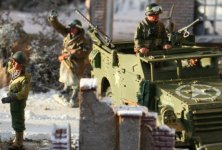
The following account has been compiled from my memory of these days; plus, the collective memories of some of the survivors of the Troop with whom I have either talked or corresponded over the years: i.e. – Paul Thompson, Richard Bradbury, William O. Tower, Arthur LaCroix, Calvin Lezzi, Howard Hughes, Edward Fleming, Robert House, Earl Liston, Michael Gresh, Jr., Willis Selje, Kenneth Booz, Abraham Freund, John Simpson, Robert Fisher, Louis Cunningham, Rudy Aittama, Ralph Pope, Michael Liskiewicz, Bill Roub, Roger Frambs, Rishel White, and the late William W. Randall, Roy Mechling, Myron Johnstone, Edward McGee, Gene Hammond, Al Orzolek, Robert Madsen; plus, no doubt others I can't quite recall. The Troop was organized on 15 March 1943 (organic to the 106th Infantry Division) and trained at Fort Jackson, South Carolina. Then participated in the Tennessee Maneuvers from January 20 through March 26, 1944.
From the Tennessee Maneuvers we moved to Camp Atterbury, Indiana, to complete our training for overseas movement. Beginning 9 October 1944, we moved to Camp Myles Standish, Massachusetts, for embarkation and shipment to the European Theater of Operations; and sailed on 10 November 1944 aboard the Wakefield. After an uneventful but rough crossing, we landed at Liverpool, England.
In England, we went by train to Stow-On-The-Wold where we received the rest of our authorized equipment, including brand new M-8 Armored cars complete with the very latest in radio equipment. After a short stay in England, we boarded an L.S.T. at Weymouth for the Channel crossing to Le Havre, France. Crossing the Channel, we encountered very rough weather. While anchored outside Le Havre Harbor waiting our turn to dock and unload, both anchors were torn loose and we had to return to Weymouth for repairs. After receiving new anchors, we repeated the crossing and a successful landing was made. After unloading, we proceeded by convoy at night across France to the vicinity of St. Vith, Belgium, arriving there on 9 December 1944.
We were attached to the 424th Infantry Regiment, and on 11 December 1944, we were placed on line during a night blackout move to replace a Rifle Company of the 23rd Infantry Regiment, 2nd Infantry Division. Our orders were to replace the Rifle Company - man for man, gun for gun.... Plus, we were ordered to maintain complete radio silence; dismount our .30-caliber machine guns from our vehicles; hide the vehicles in various buildings in the village of Grosslangenfeld, which we were to occupy; then assume the mission of a Rifle Company in the defense.
(Note: At this time, the Troop T.O.& E. authorized –
6 officers;
149 enlisted men;
13 - M-8 Armored Cars;
99 - .30-caliber M-1 carbines;
13 - .30-caliber machine guns (light);
3 - .50-caliber machine guns;
30 - .45-caliber submachine guns;
5 - Rocket Launchers A.T.;
9 - 60 mm mortars;
26 - .30-caliber M-l Rifles;
24 - l/4 ton trucks;
5 - M-3 halftracks; and
1 - 2&l/2 ton truck (mess truck)
We were positioned facing the Siegfried Line, with the 424th Infantry Regiment’s Cannon Company on our right (we could not see their nearest position to us) and Troop B, 18th Cavalry Reconnaissance Squadron on our left (nor could we see their nearest position to us either). Most of our vehicles were placed where we couldn't readily utilize them. We had a full complement of officers and about 85% of our authorized enlisted personnel and attempted to man the positions vacated by the Rifle Company in Grosslangenfeld. We were forbidden to test fire our machine guns and 37 mm cannons on the armored cars, or to fire in our final protective line. We were ordered to use the range cards previously established by the Rifle Company so the Germans would believe the same Unit was still in place. There were no provisions for artillery support, or any other supporting fire for us. We were told this was a quiet sector or rest camp!! Since we were forbidden to use our radios, our only communication with other Units was a telephone line to the 424th Infantry Regiment. (It was years later that we learned all the other Units in the area had radio contact with Division.)
The only contact we could recall from the ‘outside’ was the visit by a Red Cross Doughnut Mobile on the 13th or 14th of December that served us coffee and doughnuts, complete with music and the smiles of two American women!
At approximately 5:30 A.M. on 16th December 1944, we came under attack by German artillery, rockets, and mortars. This attack set fire to several buildings in the village, including my Command Post. The barn where our ammunition trailer had been hidden took a direct hit during the night of December 16-17, and our ammunition supply was destroyed except for the small amounts we had placed at various platoon positions. Shortly after the initial shelling ceased, German infantry began to advance toward our positions in Grosslangenfeld. We were successful in repulsing them with small arms, machine guns, and 60 mm mortar fire; the mortar ammunition was soon exhausted. Later in the morning, another attack was mounted, and again repulsed, with heavy losses to the Germans.
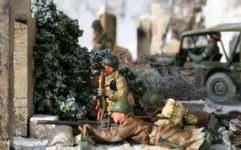
During the shelling and early ground attacks, three of our men were seriously wounded — Sgt. Arthur LaCroix, T/5 Willis Selje, and Pfc Robert House. Since our only medical service consisted of platoon medics, the Troop Commander decided to send the wounded to the rear. A halftrack was disarmed, and red crosses affixed to the sides, to transport the wounded to the nearest medical facility. Along with the driver, T/5 James Guthrie, volunteers Medic Abraham Freund and Supply Clerk Cpl. Howard Hughes accompanied the wounded. The volunteers were to deliver our wounded to a medical facility, report our situation, rearm, draw as much ammunition as they could transport and return to our position. They never returned. (Years later, it was learned they had successfully reached St. Vith, delivered the wounded (all survived their wounds), reported our situation, rearmed, drew a supply of ammunition, and attempted to return to Grosslangenfeld. Unfortunately, by the time they were able to begin the return trip, German troops had moved into the area between St. Vith and Grosslangenfeld.)




